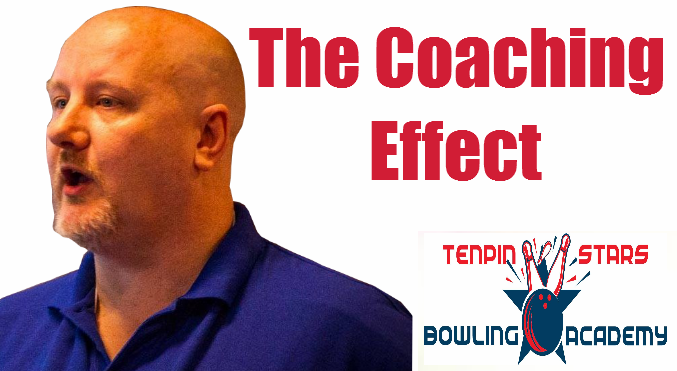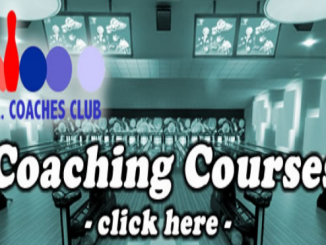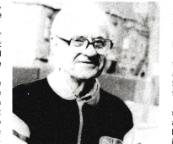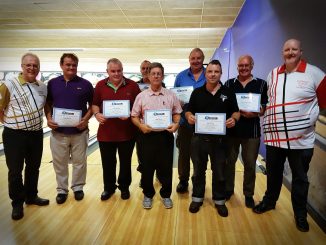
Welcome to my new regular column talking about the “coaching effect, and how this relates to coaches, bowlers, and the business of tenpin. The purpose of this column is to help build the importance of coaching within our sport and in particular the balance between training and competition at different stages of player development. I will look to share my experience and knowledge from the perspective of the bowler and as a coach. I hope you find it an enjoyable read and beneficial.
The FUNdamentals of Bowling
When defining biomechanically, the skills required in tenpin bowling are “closed” as the player determines when they start and stop their technique. As competitive bowlers know, the environment on which the game is played (the lane) has oil placed on it and this can be applied in different volumes, different lengths, not uniformly, different viscosity, and is invisible to the naked eye. Each shot delivered alters the oil pattern and removes a tiny bit of it, and only through perception and experience can a player gauge where the oil is and just as importantly where it is not, thus creating an “open” skill dynamic. During execution of the delivery a bowler primarily uses gross motor skills, the legs, glutes, back, and core muscles; and fine motor skills mostly at the point of release, combined with hand-eye coordination which create a “series of discrete skills” when performing their sport.
Despite the complexity and refinement of movement patterns required to perform tenpin bowling to a high level, and regardless of the huge number of competitive and enthusiasts playing our sport – the U.S. Census Bureau in 2009 suggested that nearly 45 million people participated in bowling more than once in the U.S.A, and per the website of the governing body, World Bowling (who govern 134 federations), there are over 200 million participants and 4 million competitors world-wide – the focus on and development of fundamental movement patterns in our sport has had very little if any attention or teaching.
This article will recognise the abilities and skills required to play our sport and how coaches can aid development in early years through application and understanding of basic scientific theories used in other sports.
Martindale, Collins, and Abraham (2006) research data concluded that sport capability development is reliant upon a wide variety of skills such as fundamental movements, decision-making, life and mental skills, more generic, but important for the basis upon which more sport-specific development may take place. They stated that the German Tennis Federation (DTB, 1992) use a mixture of mini tournaments as well as motor-ability tests, to select children as young as six for development training. Balyi and Hamilton (2004) who discuss trainability in childhood and adolescence make the point that coaches design athlete training plans based on chronological age even though this age group demonstrates a wide range of physical, cognitive, and emotional development. Their solution to this is to use the onset of Peak Height Velocity (PHV) described by them as “a reference point that provides valuable information for training the athletes’ energy systems and Central Nervous System (CNS), regardless of chronological age”. By monitoring PHV critical periods of trainability can be exploited to improve short and long term development. The model of Long Term Athletic Development classifies sports into either Early Specialization or Late Specialization with four and six stages respectively as Table 1 shows.
Table 1: Balyi and Hamilton (2004) Early and Late Specialization model stages.
According to the Canada Sport for Life website (who cite Balyi) Tenpin Bowling falls into the “Common Late Specialization” group of sports because participants will benefit from developing a general athletic ability via a range of different activities before focussing on sport specific skills.
Underlying Fundamental Movements
When assessing the development needs of (particularly) a young bowler a coach must look beyond bowling specific skills. A child will develop their physical literacy in many ways and at different speeds and so it is vital that we as coaches recognise individual capabilities. To maximise potential of athletes we first need to understand what fundamental movements and specialised movements are required to play the sport of tenpin bowling (one-handed modern style) per Gallahue & Ozman, 2006 and detailed in table 2. Proficiency in fundamental movements is key to proficiency in specialised movements and subsequently high sporting capability.
Table 2: The fundamental and specialised movements for tenpin bowling per Gallahue and Ozman, 2006
Coaches that can apply methods to improve physical literacy at a young age where necessary will have a very positive affect on potential. Traditionally tenpin bowling has attracted less athletic people to the game and children who may not have had a wide range of physical activity in their formative years. This is a challenge that the sport will continue to face but as more coaches teach the (ETBF) “modern style” and “two-handed style” our players need to be more athletic in terms of flexibility, and endurance in the large muscles; glutes, abdominals, thighs and lower back to become high performers. As such the awareness to recognise these development needs and to be able to train non-sport specific skills will be increasingly important in the future of our sport. The BTBA FUNdamentals Qualification and BowlU’ s Fun First and other programs are at the forefront of this progress. Traditionally we have taught a “classic style” of play which works against natural body mechanics and where synchronisation between ball swing and feet movement restricts other elements. This style benefits players with lesser physical literacy and hinders more athletic and flexible individuals because they attempt to play with higher backswings, faster legs speeds and more upper body movement. Preventing injury is paramount in the coaching effect.
Underlying Abilities
Fleishman developed 52 human abilities that range from verbal comprehension to selective attention (Fleishman et al., 1984). Abilities are genetically predetermined characteristics that affect movement performance such as agility, coordination, strength, and flexibility. Abilities are enduring and as such, difficult to change in adults. Abilities differ from skills in the sense that skills are learned, whereas abilities are a product of both learning and genetic factors (Fleishman, 1964). Skills are a level of proficiency on a specific motor task, while abilities are part of an individual’s traits that affect their capability to become skillful when learning a new motor task. For example, abilities that are required for a skilled race car driver include rate control, manual dexterity, stamina, control precision, and reaction time; a typist needs to have abilities in aiming and finger dexterity; a surgeon requires arm-hand steadiness and multilimb coordination; and a figure skater performing the triple axel requires abilities such as explosive strength, dynamic flexibility, gross body coordination, and multilimb coordination (Haibach, Reid, & Collier, 2011)
Below details a task analysis for the tenpin bowling delivery (adapted from Magill 2001) and the perceptual motor abilities and the physical proficiency abilities derived from Fleishman’s taxonomy of human perceptual and physical abilities and task analysis (1962).
Tasks performed during the (modern style – one handed) tenpin bowling delivery.
Perceptual Motor Abilities
Multiple Coordination – Ability to coordinate movements of two or more limbs while the individual is sitting, standing, or lying down (Key to timing, used at the start of the delivery action)
Manual Dexterity – Ability to make skillful coordinated movements of one hand; also, involves the degree to which these movements can carried out quickly (key through the release window)
Finger Dexterity – Ability to make skillful coordinated movements of the fingers of one or both hands to grasp (used to keep the ball on the hand with minimal force (grip/squeeze) during the delivery action)
Arm-hand Steadiness – Ability to keep the hand or arm steady. It includes steadiness while making an arm movement as well as while holding the arm and hand in one position. This ability does not involve strength or speed (most applicable to the non-bowling arm)
Wrist/finger Speed – Ability to make fast, simple repeated movements of the fingers, hands and wrists. It involves little, if any, accuracy or eye-hand coordination (during the release; distance and speed wrist/fingers travel around the circumference of the ball will determine rev rate)
Visualization – Ability to imagine how something will look when it is moved around or when its parts are moved or rearranged. It requires the forming of mental images of how patterns or objects would look after certain changes, such as unfolding or rotation. One must predict how an object, set of objects or pattern will appear after the changes are carried out (critical to lane play and strategy)
Physical Proficiency Abilities
Dynamic Strength – Ability of the muscles to exert force repeatedly or continuously over a long-period. This is the ability to support, hold up or move the body’s own weight and/or objects repeatedly over time. It represents muscular endurance and emphasizes the resistance of the muscles to fatigue (critical in competition, long days and successive days)
Explosive Strength – Ability to use short bursts of muscle force to propel oneself or an object. It requires gathering energy for bursts of muscle effort over a very short time. (not used extensively in modern style one-handed technique but is in two-handed style during downswing and release)
Trunk Strength – Involves the degree to which one’s stomach and lower back muscles can support part of the body repeatedly or continuously over time. The ability involves the degree to which these trunk muscles do not fatigue when they are put under such repeated or continuous strain (critical in competition, long days and successive days)
Extent Flexibility – Ability to bend, stretch, twist, or reach out with the body, arms or legs (particularly key during last two steps and the release)
Gross Body Coordination – Ability to coordinate the movement of the arms, legs and torso together in activities in which the whole body is in motion (key to overall efficiency and repeatability)
Gross Body Equilibrium – Ability to keep or regain one’s body balance or stay upright when in an unstable position. This ability includes maintaining one’s balance when changing direction while moving or standing motionlessly (key in a sport where one side of the body is carrying/swinging a heavy object. Equilibrium is key at certain points in the modern style)
The United States Bowling Congress use a series of tests with their representative teams at all ages, and look at sport specific skills as well as athletic ability. To measure functional movement, they use a series of tests, and table 3 shows the tests and the relationship to the perceptual and physical abilities. I have added Fleishman’s Abilities alongside each test for understanding.
Table 3: physical tests related to Fleishman’s Taxonomy of physical and perceptual abilities.
Fleishman’s taxonomy of human perceptual and physical abilities and task analysis (1962) shows that tenpin bowlers use a wide range of physical and perceptual skills, in a sport which demands high levels of repeatability, for potentially long periods of time, whilst propelling an object up to 16lb in weight.
This emphasis on repeating the same basic skill efficiently within a set environment (albeit that the invisible playing field which is the pattern of the oil, minutely changes after each shot) means that there are limits to how practice can be performed. The only moving object is the ball that the player controls until release and so it is vital that bowlers have reached maturation in their development of fundamental movement patterns before focussing on sport specific movement patterns, if they wish to excel in the sport. The key to our future success involves two distinct points; firstly, that we encourage our players during their early years (up to around 11-13, depending on gender) to play a variety of sports and engage in other activities that are more mentally stimulating; and secondly that we do not force sport specific training onto the body of young children before they are ready.
The expert coach in fundamentals will play a vital role in the future development of our sport, recognition on a wider sporting landscape, and in the potential of our athletes
More next month – Catch up with Volume 1 – The Coaching Effect here
References
Balyi. I., & Hamilton. A. (2004) Long-Term Athlete Development: Trainability in Childhood and Adolescence. Windows of Opportunity, Optimal Trainability. Victoria: National Coaching Institute British Columbia & Advanced Training and Performance Ltd
Fleishman, E.A. (1962). The description and prediction of perceptual motor skill learning. In R. Glasser (Ed.), Training research and education (pp. 137-175). Pittsburgh, PA: University of Pittsburgh.
Gallahue, D.L. & Ozmun, J.C. (2011). Understanding Motor Development: Infants, Children, Adolescents, Adults. New York: McGraw-Hill International
Gentile, A.M. (2000). Skill Acquisition: Action, Movement, and the Neuromotor Processes. In J.H. Carr & R.B. Shepard (eds.), Movement Science: Foundations for physical therapy in rehabilitation (pp. 111-180). Rockville, MD: Aspen Publications.
Martindale, R.J.J., Collins, D. & Abraham, A. (2006). Effective Talent Development: The Elite Coach Perspective in UK Sport. Journal of Applied Sport Psychology, 19: 187-206.
http://www.census.gov/compendia/statab/2012/tables/12s1249.pdf – accessed 27/11/2014
http://www.worldbowling.org/ – accessed 27/11/2014
http://bowl.com/ – accessed 27/11/2014
http://canadiansportforlife.ca/sites/default/files/resources/bowl_ltad_english.pdf – accessed 30/11/2014
http://canadiansportforlife.ca/blog/distinctions-between-late-specialization-sports-istvan-balyi – accessed 30/11/2014
Tenpin STARS Bowling Academy offers a modern and professional option for bowlers of various ages and abilities to train on a (roughly) monthly basis in groups of 8, with the emphasis on steady and sustainable development of skills, knowledge, confidence and motivation.
ETBF Level 3 & USBC Silver Coach Mark Heathorn provides professional coaching services for bowlers and coaches at various locations.



